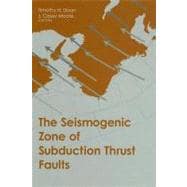
Note: Supplemental materials are not guaranteed with Rental or Used book purchases.
Purchase Benefits
What is included with this book?
| Preface | p. viii |
| Introduction | p. 1 |
| The Seismogenic Zone of Subduction Thrust Faults: Introduction | p. 2 |
| The Seismogenic Zone of Subduction Thrust Faults: What We Know and Don't Know | p. 15 |
| The Incoming Plate | p. 41 |
| Sediment Inputs to Subduction Zones: Why Lithostratigraphy and Clay Mineralogy Matter | p. 42 |
| The Thermal State of 18-24 Ma Upper Lithosphere Subducting Below the Nicoya Peninsula, Northern Costa Rica Margin | p. 86 |
| Influence of Subducting Topography on Earthquake Rupture | p. 123 |
| Convergent Margin Structure, Fluids and Subduction Thrust Evolution | p. 147 |
| Pore Pressure and Fluid Flow in the Northern Barbados Accretionary Complex: A Synthesis | p. 148 |
| Pore Pressure within Underthrust Sediment in Subduction Zones | p. 171 |
| Deformation and Mechanical Strength of Sediments at the Nankai Subduction Zone: Implications for Prism Evolution and Decollement Initiation and Propagation | p. 210 |
| The Nicaragua Convergent Margin: Seismic Reflection Imaging of the Source of a Tsunami Earthquake | p. 257 |
| How Accretionary Prisms Elucidate Seismogenesis in Subduction Zones | p. 288 |
| Laboratory Studies | p. 316 |
| Friction of the Smectite Clay Montmorillonite: A Review and Interpretation of Data | p. 317 |
| Fault Friction and the Upper Transition from Seismic to Aseismic Faulting | p. 346 |
| Laboratory-Observed Faulting in Intrinsically and Apparently Weak Materials: Strength, Seismic Coupling, Dilatancy, and Pore-Fluid Pressure | p. 370 |
| Seismic and Geodetic Studies | p. 450 |
| Asperities and Quasi-Static Slips on the Subducting Plate Boundary East of Tohoku, Northeast Japan | p. 451 |
| Anomalous Earthquake Ruptures at Shallow Depths on Subduction Zone Megathrusts | p. 476 |
| Secular, Transient and Seasonal Crustal Movements in Japan from a Dense GPS Array: Implication for Plate Dynamics in Convergent Boundaries | p. 512 |
| Elastic and Viscoelastic Models of Crustal Deformation in Subduction Earthquake Cycles | p. 540 |
| Distinct Updip Limits to Geodetic Locking and Microseismicity at the Northern Costa Rica Seismogenic Zone: Evidence for Two Mechanical Transitions | p. 576 |
| Regional Scale Deformation | p. 600 |
| Collision Versus Subduction: From a Viewpoint of Slab Dehydration | p. 601 |
| Subduction and Mountain Building in the Central Andes | p. 624 |
| List of Contributors | p. 661 |
| Index | p. 665 |
| Table of Contents provided by Ingram. All Rights Reserved. |
The New copy of this book will include any supplemental materials advertised. Please check the title of the book to determine if it should include any access cards, study guides, lab manuals, CDs, etc.
The Used, Rental and eBook copies of this book are not guaranteed to include any supplemental materials. Typically, only the book itself is included. This is true even if the title states it includes any access cards, study guides, lab manuals, CDs, etc.